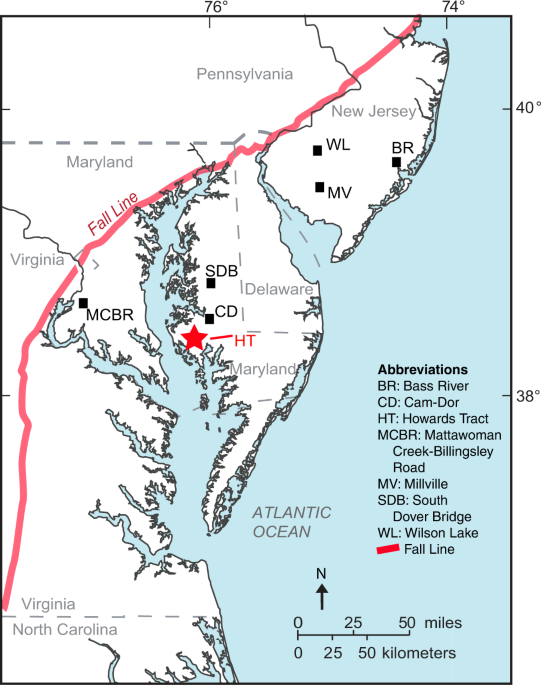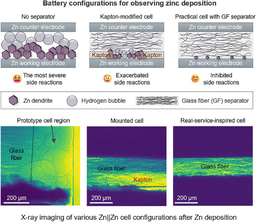In order to better understand our future world in the wake of anthropogenic climate change, researchers often look to past climate states. One such event is the Paleocene-Eocene Thermal Maximum, or PETM, which has been argued to be one of the closest analogues for modern-day warming. However, in many respects, the changes that are taking place today are entirely unique, both in the rate of carbon dioxide changes in the atmosphere, as well as in the antecedent climate. Therefore, it is important to have a complete understanding of the rate and magnitude of past climate changes in order to better contextualize the measurements we have made from these time periods.
The PETM and the Mid-Atlantic
The Paleocene-Eocene Thermal Maximum occurred roughly 56 million years ago and lasted about 200,000 years. Although the world of the Paleocene was quite warm compared to today (about 24-25°C compared to about 14°C in the modern era), temperatures rose by an additional 5-6°C during the PETM. This led to dramatic precipitation pattern changes and ocean acidification, while polar regions became warm enough to resemble today’s tropics. Despite agreement on the types of changes that took place, researchers still debate the source of the carbon that drove these changes as well as the period of time in which that carbon was released. To understand how carbon is absorbed by the oceans and how different regions respond to certain degrees of CO2-induced warming, it is crucial to constrain both the magnitude and timing of CO2 release.
To better understand what happened during the PETM, researchers look to the sediments deposited during that time. Sediments deposited in the open ocean have a nearly continuous deposition, but the aforementioned ocean acidification dissolved the carbonate deposits, leaving a gap in many of the PETM records. Therefore, our team turned our attention to shallow marine sediments on the Mid-Atlantic coastal plain of the United States. This region has remarkably well-preserved sediments across this time interval, allowing us to characterize the onset of the event.
Constraining the Timing
To calculate the timing of the event, we utilized a technique called astrochronology. Unlike previous studies in the region which used biostratigraphic ages, or the age relationships of certain fossils, astrochronology relies upon the regular changes in Earth’s orbit to calculate ages and provides much higher resolution data. As Earth orbits around the sun, there are three primary ways in which its orbit changes, each with its own regular periodicity. The longest cycle is eccentricity, in which the orbit changes in overall shape and occurs on approximately 100,000-year cycles with major changes taking place over 405,000-year cycles. The next is obliquity, which is the tilt of the Earth relative to the orbital plane, which changes on 41,000-year cycles. The shortest cycle is precession, or the direction the tilt of the Earth is pointing, which changes on 21,000-year cycles. Collectively, these changes are referred to as Milankovitch cycles, and they can cause changes to the climate through the amount of sunlight that reaches a particular region. These climatic changes in turn drive changes in the type of sediment being deposited in that region.
We utilized high-resolution data of calcium content as well as the magnetic susceptibility of sediments deposited across the Paleocene-Eocene boundary. Calcium is a primary component of carbonate rocks and therefore can be used to estimate the amount of carbonate being deposited within the sediments, which is known to vary in response to astronomically forced climate change. Likewise, magnetic susceptibility measures the concentration of magnetic minerals and provides information regarding the proportion of sediment being carried to the ocean from the continent. Both measurements showed regular periodicity. By analyzing the periodicity in special statistical software, we isolated the particular components of the Milankovitch cycles that are driving the observed changes, and in turn, the timing of the event.
What do these observations tell us?
Most significantly, we have constrained the timing of the onset of the PETM to 6,000 years. Previous estimates ranged from as long as 20,000 years to as short as 13 years. In constraining the timing to 6,000 years, this allows us to refine our carbon cycle models to better understand how the planet reacts to an injection of carbon over these timescales as well as narrow the possibilities for the source of the carbon that drove the PETM.
Scientists have also debated the impact of changes to the Earth’s orbit on the onset of the PETM, as independent models of Milankovitch cycles break down before reaching the event. This study demonstrates that the PETM likely occurred during the most extreme phase of eccentricity, suggesting that these orbital cycles may have played a role in the onset of the PETM.
Our analysis also reveals far lower changes in sedimentation rates than previously thought. Previous research utilizing biostratigraphic ages calculated sedimentation rate changes of anywhere between 2.8 to 220-fold increases. However, these previous records are quite low resolution and are more indicative of long-term averages than short-term responses. Our new analysis provides a high-resolution calculation directly across the boundary of the late Paleocene and the PETM, providing greater insight into the nature of hydrologic and sedimentologic changes in the region.
Finally, our research provides insight into the relationship between carbonate deposition, the PETM, and orbital forcing. Our results demonstrate that changes in insolation, or the amount of sunlight reaching the Earth’s surface, likely drove changes in weathering rates in the region and, in turn, carbonate deposition. In relation to the PETM, while the carbon release caused short-term acidification, we find evidence for a second phase of carbonate overshoot, which influenced the recovery from the event.
Follow the Topic
-
Nature Communications

An open access, multidisciplinary journal dedicated to publishing high-quality research in all areas of the biological, health, physical, chemical and Earth sciences.
Related Collections
With Collections, you can get published faster and increase your visibility.
Clinical trials 2025
Publishing Model: Open Access
Deadline: Dec 31, 2025
Women's Health
Publishing Model: Hybrid
Deadline: Ongoing





Please sign in or register for FREE
If you are a registered user on Research Communities by Springer Nature, please sign in